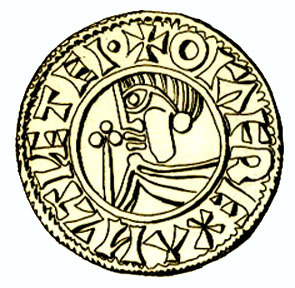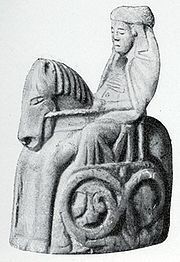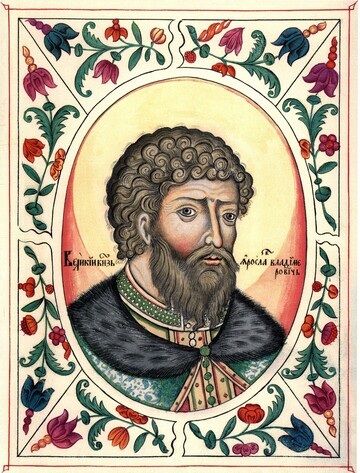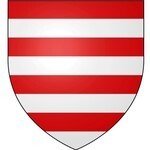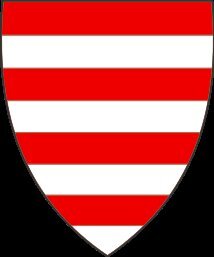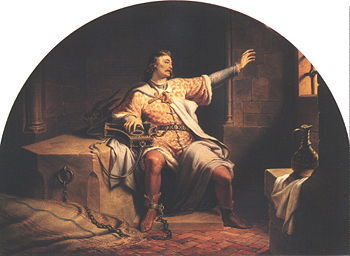maximum test » Anastasia Agmunda Ярославна "Ann of Kiev" Rurikids (± 1023-± 1074)
Données personnelles Anastasia Agmunda Ярославна "Ann of Kiev" Rurikids
- Le surnom est Ann of Kiev.
- Elle est née environ 1023Kiev
Kievian Rus (present Ukraine). - Baptisé (à 8 ans ou plus tard) par l'autorité de la prêtrise de l'église SDJ le 4 mars 1931.
- Titre: queen consort of Hungary
- Professions:
- Princess.
- en l'an 1039 Duchess of Hungary in exileKiev
Ukraine. - en l'an 1046 Queen of HungaryHungary.
- le 27 septembre 1063 Queen Mother of HungaryHungary.
- en l'an 1074 NunAdmont
Styria Austria. - Elle est décédée environ 1074Admont Abbey
Austria. - Un enfant de Iaroslav Vladimirovich the Wise the Wise et Ingegerd Olofsdotter
- Cette information a été mise à jour pour la dernière fois le 12 février 2020.
Famille de Anastasia Agmunda Ярославна "Ann of Kiev" Rurikids
Elle avait une relation avec Andrew I "the White" "the Catholic" Árpád dynasty.
Enfant(s):
Notes par Anastasia Agmunda Ярославна "Ann of Kiev" Rurikids
{geni:about_me} ===Anastasia Yaroslavna of Kiev===
http://genealogy.euweb.cz/russia/rurik1.html#A2YM
...
*D4. [2m.] Yaroslav I "Mudriy" "the Wise", Pr of Rostov (988-1010), Pr of Novgorod (1013-15), Great Pr of Kiev (1015-17)+(1019-54), *ca 986, +20.2.1054, bur St.Sophia Cathedral; 1m: Saint Anna (+1018, bur St.Sophia Cathedral); m.1019 Pss Ingigerd Olafsdottir of Sweden (+10.2.1050, bur St.Sophia Cathedral)
** ...
**E6. [2m.] '''Anastasia (Agmund), *ca 1023, +after 1074'''; m.Kiev 1037/38 King András I of Hungary (*1014 +1060)
-------------------------
http://en.wikipedia.org/wiki/Anastasia_of_Kiev
'''Anastasia of Kiev (c. 1023 – 1074/1096) was Queen of Hungary''' as the wife of King Andrew the White. She was the eldest daughter of Grand Prince Yaroslav I the Wise of Kiev and Ingigerd of Sweden, and the older sister of Anne of Kiev, Queen consort of Henry I of France.
Around 1039, Anastasia was married to Duke Andrew of Hungary, who had settled down in Kiev after his father Vazul took part in a failed assassination attempt aimed at King Stephen I of Hungary.
In 1046, her husband returned to Hungary and ascended the throne as King Andrew I after defeating King Peter I. Anastasia followed her husband to the kingdom. It was probably she who persuaded her husband to set up a lavra in Tihany for hermits who had come to Hungary from the Kievan Rus'. The royal couple did not have a son till 1053, when Anastasia gave birth to Solomon. However, Solomon's birth and later coronation caused an embittered conflict between King Andrew I and his younger brother Duke Béla, who had been the heir to the throne till the child's birth.
When Duke Béla rose in open rebellion against King Andrew in 1060, the king sent his wife and children to the court of Adalbert, Margrave of Austria. King Andrew was defeated and died shortly afterwards, and his brother was crowned King of Hungary on 6 December 1060.
Anastasia sought the help of King Henry IV of Duitsland, whose sister, Judith had been engaged to the child Solomon in 1058. By the time the German troops entered to Hungary to give assistance to Solomon against his uncle, King BélaI died on 11 September 1063 had died and his sons, Géza, Ladislaus and Lampert fled to Poland.
The young Solomon was crowned around 27 September 1063. On the occasion of her son's coronation, Anastasia presented the alleged sword of Attila the Hun to Duke Otto II of Bavaria who was the leader of the German troops. Between 1060 and 1073 King Solomon governed his kingdom in collaboration with his cousins, Dukes Géza, Ladislaus and Lampert who had returned to Hungary and accepted his rule. However, in 1074 the three brothers rebelled against their cousin, and defeated him on 14 March 1074. King Solomon run to the Western borders of Hungary where he could only maintain his rule only over the counties of Moson and Pozsony (Slovak: Bratislava).
Anastasia followed her son, but they began to argue with each other and she moved to Admont Abbey where she lived as a nun till her death. She was buried in the Abbey.
--------------------
Adelaide of Hungary (c. 1040 – 27 January 1062) was the only daughter of Andrew I of Hungary of the Arpad dynasty. It is disputed whether her mother was '''Anastasia Yaroslavna''', daughter of Yaroslav the Great, Prince of Kiev, or another unknown first wife of Andrew I.
She was the second wife of Vratislav II of Bohemia, whom she married in 1057. She was a good dynastic match for Vratislav, as he profited from the alliance with her father. They had four children, including Bretislaus II of Bohemia and Judith Premyslid. Vratislav became duke in 1061, after death of his brother, but Adelaide was not duchess for a long time.
She preceded her husband in death; he remarried shortly afterward to Świętosława of Poland, and was finally crowned as the first King of Bohemia in 1085.
--------------------
Anastasia of Kiev
From Wikipedia, the free encyclopedia
Anastasia of Kiev (c. 1023 – 1074/1096) was Queen of Hungary as the wife of King Andrew the White. She was the eldest daughter of Grand Prince Yaroslav I the Wise of Kiev and Ingigerd of Sweden, and the older sister of Anne of Kiev, Queen consort of Henry I of France.
Around 1039, Anastasia was married to Duke Andrew of Hungary, who had settled down in Kiev after his father Vazul took part in a failed assassination attempt aimed at King Stephen I of Hungary.
In 1046, her husband returned to Hungary and ascended the throne as King Andrew I after defeating King Peter I. Anastasia followed her husband to the kingdom. It was probably she who persuaded her husband to set up a lavra in Tihany for hermits who had come to Hungary from the Kievan Rus'. The royal couple did not have a son till 1053, when Anastasia gave birth to Solomon. However, Solomon's birth and later coronation caused an embittered conflict between King Andrew I and his younger brother Duke Béla, who had been the heir to the throne till the child's birth.
When Duke Béla rose in open rebellion against King Andrew in 1060, the king sent his wife and children to the court of Adalbert, Margrave of Austria. King Andrew was defeated and died shortly afterwards, and his brother was crowned King of Hungary on 6 December 1060.
Anastasia sought the help of King Henry IV of Duitsland, whose sister, Judith had been engaged to the child Solomon in 1058. By the time the German troops entered to Hungary to give assistance to Solomon against his uncle, King BélaI died on 11 September 1063 had died and his sons, Géza, Ladislaus and Lampert fled to Poland.
The young Solomon was crowned around 27 September 1063. On the occasion of her son's coronation, Anastasia presented the alleged sword of Attila the Hun to Duke Otto II of Bavaria who was the leader of the German troops. Between 1060 and 1073 King Solomon governed his kingdom in collaboration with his cousins, Dukes Géza, Ladislaus and Lampert who had returned to Hungary and accepted his rule. However, in 1074 the three brothers rebelled against their cousin, and defeated him on 14 March 1074. King Solomon run to the Western borders of Hungary where he could only maintain his rule only over the counties of Moson and Pozsony (Slovak: Bratislava).
Anastasia followed her son, but they began to argue with each other and she moved to Admont Abbey where she lived as a nun till her death. She was buried in the Abbey.
Marriage and children
# c. 1039: King Andrew I of Hungary (c. 1015 – before 6 December 1060)
Adelaide (c. 1040 – 27 January 1062), wife of king Vratislaus II of Bohemia
King Solomon of Hungary (1053 – 1087 or after)
David of Hungary (after 1053 – after 1094)
--------------------
Død efter 1074
--------------------
From the Foundation for Medieval Genealogy page on Russia Rurikid:
http://fmg.ac/Projects/MedLands/RUSSIA,%20Rurik.htm#_Toc198014254
ANASTASIA Iaroslavna ([1023]-[1074/1096], bur Admont Abbey).
Baumgarten names the second wife of King András and gives her origin but only cites one secondary source in support[163]. The primary source which confirms her parentage and marriage has not yet been identified.
After her husband's death in 1060, she and her sons took refuge at the court of Heinrich IV King of Duitsland but, leaving her elder son there, she and her younger son went to Austria[164].
The Annals of Lambert record that "regina Ungariorum, mater Salomonis regis" presented the sword of "rex Hunnorum Attila" to "duci Baioriorum Ottoni" after her son was restored as king of Hungary[165].
She became a nun at Admont in 1074 as AGMUNDA.
m ([1039]) as his second wife, ANDRÁS of Hungary, son of VÁSZOLY [Vazúl] Prince of Hungary Duke between March and Gran & --- of the Bulgarians ([1014]-Zirc autumn 1060, bur Tihany, Abbey of St Anian).
He succeeded in 1047 as ANDRÁS I "the Catholic" King of Hungary.
From the Wikipedia page on Anastasia of Kiev:
http://en.wikipedia.org/wiki/Anastasia_of_Kiev
Anastasia of Kiev (c. 1023 – 1074/1096) was Queen of Hungary as the wife of King Andrew I the White.
(Hungarian Wikipedia says that she was born in Kiev in 1023, and died in Admont, Styria, Austria, in 1096.)
She was the eldest daughter of Grand Prince Yaroslav I the Wise of Kiev and Ingigerd of Sweden, and the older sister of Anne of Kiev, Queen consort of Henry I of France.
Life
Around 1039 (Hungarian Wikipedia says 1037-1038), Anastasia was married to Duke Andrew of Hungary, who had settled down in Kiev after his father Vazul took part in a failed assassination attempt aimed at King Stephen I of Hungary.
In 1046, her husband returned to Hungary and ascended the throne as King Andrew I after defeating King Peter I Orseolo. Anastasia followed her husband to the kingdom.
It was probably she who persuaded her husband to set up a lavra in Tihany for hermits who had come to Hungary from the Kievan Rus'. (Hungarian Wikipedia says that she lived on the Tihany peninsula on Lake Balaton. She also foundedthe Bihari Tormova monastery for Russian nuns.)
The royal couple did not have a son till 1053, when Anastasia gave birth to Solomon. However, Solomon's birth and later coronation caused an embittered conflict between King Andrew I and his younger brother Duke Béla, who had beenthe heir to the throne til the child's birth.
When Duke Béla rose in open rebellion against King Andrew in 1060, the king sent his wife and children to the court of Adalbert, Margrave of Austria. King Andrew was defeated and died shortly afterwards, and his brother was crowned King of Hungary on 6 December 1060.
Anastasia sought the help of King Henry IV of Duitsland (future Holy Roman Emperor), whose sister, Judith had been engaged to Solomon when he was a child in 1058. By the time Imperial troops entered Hungary to give assistance to Solomon against his uncle, King Béla I died on 11 September 1063 and his sons, Géza, Ladislaus, and Lampert fled to Poland.
The young Solomon was crowned around 27 September 1063. On the occasion of her son's coronation, Anastasia presented the alleged sword of Attila the Hun to Duke Otto II of Bavaria who was the leader of the Imperial troops.
Between 1060 and 1073 King Solomon governed his kingdom in collaboration with his cousins, Dukes Géza, Ladislaus, and Lampert who had returned to Hungary and accepted his rule. However, in 1074 the three brothers rebelled against their cousin, and defeated him on 14 March 1074. King Solomon fled to the Western borders of Hungary where he maintained his rule only over the counties of Moson and Pozsony (Slovak: Bratislava).
Anastasia followed her son, but they began to argue with each other and she moved to Admont Abbey (in 1074) where she lived as a nun till her death (in 1096). She was buried in the Abbey.
(Hungarian Wikipedia says that the Thuroczy Chronicle recorded where Anastasia admonished her son: "My dear boy! Several others did not listen to me either, nor supported my advice. On the contrary, they were silent. What happenedto you? Rally yourself and your men. Do not say that you have had enough of the Hungarian crown, that in order to live in peace you must give up part of your kingdom. We can no longer watch, Prince, while you cannot keep your power." Solomon almost hit his mother after she said these words, and only Judith, his wife, prevented him. Anastasia never resolved the conflict between Bela and Solomon.)
Marriage and children
King Andrew I of Hungary (c. 1015 – before 6 December 1060):
1. Adelaide (c. 1040 – 27 January 1062), wife of king Vratislaus II of Bohemia
2. King Solomon of Hungary (1053 – 1087 or after)
3. David of Hungary (after 1053 – after 1094)
Sources
Kristó, Gyula - Makk, Ferenc: Az Árpád-ház uralkodói (IPC Könyvek, 1996)
Korai Magyar Történeti Lexikon (9-14. század), főszerkesztő: Kristó, Gyula, szerkesztők: Engel, Pál és Makk, Ferenc (Akadémiai Kiadó, Budapest, 1994)
Magyarország Történeti Kronológiája I. – A kezdetektől 1526-ig, főszerkesztő: Benda, Kálmán (Akadémiai Kiadó, Budapest, 1981)
--------------------
Wiklopedia:
Anastasia av Kiev (född cirka 1023 i Kiev, avled efter 1074) var drottning av Ungern. Hon var dotter till Jaroslav I av Kiev och Ingegerd Olofsdotter av Sverige. Hon var gift med Andreas I av Ungern.
Barn [redigera]
1. Adelaide av Ungern
2. Salomon I av Ungern (kung av Ungern)
--------------------
Anastasia of Kiev (c. 1023 – 1074/1096) was Queen of Hungary as the wife of King Andrew the White. She was the eldest daughter of Grand Prince Yaroslav I the Wise of Kiev and Ingigerd of Sweden, and the older sister of Anne of Kiev, Queen consort of Henry I of France.
Around 1039, Anastasia was married to Duke Andrew of Hungary, who had settled down in Kiev after his father Vazul took part in a failed assassination attempt aimed at King Stephen I of Hungary.
In 1046, her husband returned to Hungary and ascended the throne as King Andrew I after defeating King Peter I. Anastasia followed her husband to the kingdom. It was probably she who persuaded her husband to set up a lavra in Tihany for hermits who had come to Hungary from the Kievan Rus'. The royal couple did not have a son till 1053, when Anastasia gave birth to Solomon. However, Solomon's birth and later coronation caused an embittered conflict between King Andrew I and his younger brother Duke Béla, who had been the heir to the throne till the child's birth.
When Duke Béla rose in open rebellion against King Andrew in 1060, the king sent his wife and children to the court of Adalbert, Margrave of Austria. King Andrew was defeated and died shortly afterwards, and his brother was crowned King of Hungary on 6 December 1060.
Anastasia sought the help of King Henry IV of Duitsland, whose sister, Judith had been engaged to the child Solomon in 1058. By the time the German troops entered to Hungary to give assistance to Solomon against his uncle, King BélaI died on 11 September 1063 had died and his sons, Géza, Ladislaus and Lampert fled to Poland.
The young Solomon was crowned around 27 September 1063. On the occasion of her son's coronation, Anastasia presented the alleged sword of Attila the Hun to Duke Otto II of Bavaria who was the leader of the German troops. Between 1060 and 1073 King Solomon governed his kingdom in collaboration with his cousins, Dukes Géza, Ladislaus and Lampert who had returned to Hungary and accepted his rule. However, in 1074 the three brothers rebelled against their cousin, and defeated him on 14 March 1074. King Solomon run to the Western borders of Hungary where he could only maintain his rule only over the counties of Moson and Pozsony (Slovak: Bratislava).
Anastasia followed her son, but they began to argue with each other and she moved to Admont Abbey where she lived as a nun till her death. She was buried in the Abbey.
--------------------
Source: http://www.thefullwiki.org/Anastasia_of_Kiev
Anastasia of Kiev (c. 1023 – 1074/1096) was Queen of Hungary as the wife of King Andrew the White. She was the eldest daughter of Grand Prince Yaroslav I the Wise of Kiev and Ingigerd of Sweden, and the older sister of Anne of Kiev, Queen consort of Henry I of France.
Around 1039, Anastasia was married to Duke Andrew of Hungary, who had settled down in Kiev after his father Vazul took part in a failed assassination attempt aimed at King Stephen I of Hungary.
In 1046, her husband returned to Hungary and ascended the throne as King Andrew I after defeating King Peter I. Anastasia followed her husband to the kingdom. It was probably she who persuaded her husband to set up a lavra in Tihany for hermits who had come to Hungary from the Kievan Rus'. The royal couple did not have a son till 1053, when Anastasia gave birth to Solomon. However, Solomon's birth and later coronation caused an embittered conflict between King Andrew I and his younger brother Duke Béla, who had been the heir to the throne till the child's birth.
When Duke Béla rose in open rebellion against King Andrew in 1060, the king sent his wife and children to the court of Adalbert, Margrave of Austria. King Andrew was defeated and died shortly afterwards, and his brother was crowned King of Hungary on 6 December 1060.
Anastasia sought the help of King Henry IV of Duitsland, whose sister, Judith had been engaged to the child Solomon in 1058. By the time the German troops entered to Hungary to give assistance to Solomon against his uncle, King BélaI died on 11 September 1063 had died and his sons, Géza, Ladislaus and Lampert fled to Poland.
The young Solomon was crowned around 27 September 1063. On the occasion of her son's coronation, Anastasia presented the alleged sword of Attila the Hun to Duke Otto II of Bavaria who was the leader of the German troops. Between 1060 and 1073 King Solomon governed his kingdom in collaboration with his cousins, Dukes Géza, Ladislaus and Lampert who had returned to Hungary and accepted his rule. However, in 1074 the three brothers rebelled against their cousin, and defeated him on 14 March 1074. King Solomon run to the Western borders of Hungary where he could only maintain his rule only over the counties of Moson and Pozsony (Slovak: Bratislava).
Anastasia followed her son, but they began to argue with each other and she moved to Admont Abbey where she lived as a nun till her death. She was buried in the Abbey.
Marriage and children
# c. 1039: King Andrew I of Hungary (c. 1015 – before 6 December 1060)
Adelaide (c. 1040 – 27 January 1062), wife of king Vratislaus II of Bohemia
King Solomon of Hungary (1053 – 1087 or after)
David of Hungary (after 1053 – after 1094)
Sources
Kristó, Gyula - Makk, Ferenc: Az Árpád-ház uralkodói (IPC Könyvek, 1996)
Korai Magyar Történeti Lexikon (9-14. század), főszerkesztő: Kristó, Gyula, szerkesztők: Engel, Pál és Makk, Ferenc (Akadémiai Kiadó, Budapest, 1994)
Magyarország Történeti Kronológiája I. – A kezdetektől 1526-ig, főszerkesztő: Benda, Kálmán (Akadémiai Kiadó, Budapest, 1981)
Preceded by
Unknown Queen Consort of Hungary
1046–1060 Succeeded by
Adelaide/Rixa of Poland
Categories: Hungarian queens consort | Medieval women | 1020s births | 11th-century deaths
--------------------
http://wc.rootsweb.ancestry.com/cgi-bin/igm.cgi?op=GET&db=:2755307&id=I559000328
http://en.wikipedia.org/wiki/Anastasia_of_Kiev
Barre chronologique Anastasia Agmunda Ярославна "Ann of Kiev" Rurikids
Cette fonctionnalité n'est disponible que pour les navigateurs qui supportent Javascript.
Cliquez sur le nom pour plus d'information.
Symboles utilisés:  grand-parents
grand-parents
 parents
parents
 frères/soeurs
frères/soeurs
 enfants
enfants
 grand-parents
grand-parents
 parents
parents
 frères/soeurs
frères/soeurs
 enfants
enfants
Ancêtres (et descendants) de Anastasia Agmunda Ярославна Rurikids
Anastasia Agmunda Ярославна Rurikids 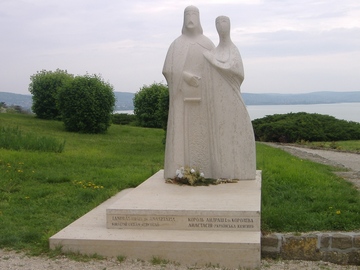 | |||||||||||||||||||||||||||||||||||
Andrew I "the White" "the Catholic" Árpád dynasty | |||||||||||||||||||||||||||||||||||
Les données affichées n'ont aucune source.
Des liens dans d'autres publications
On rencontre cette personne aussi dans la publication:Événements historiques
Jour du baptême 4 mars 1931
- La température au 4 mars 1931 était entre -2,3 et 5,5 °C et était d'une moyenne de 0,9 °C. Il y avait 8,8 heures de soleil (80%). La force moyenne du vent était de 3 Bft (vent modéré) et venait principalement du est nordest. Source: KNMI
- Du 10 août 1929 au 26 mai 1933 il y avait aux Pays-Bas le cabinet Ruys de Beerenbrouck III avec comme premier ministre Jonkheer mr. Ch.J.M. Ruys de Beerenbrouck (RKSP).
- En l'an 1931: Source: Wikipedia
- La population des Pays-Bas était d'environ 7,9 millions d'habitants.
- 27 janvier » premier gouvernement de Pierre Laval.
- 3 mars » The Star-Spangled Banner devient l'hymne national des États-Unis.
- 5 mars » signature du pacte Gandhi-Irwin.
- 4 avril » lancement officiel de la croisière jaune, reliant Beyrouth à Pékin, et qui, pendant près d'une année, ouvre la «Route de la soie» à la circulation automobile.
- 8 août » les travailleurs entrent en grève au barrage Hoover.
- 7 novembre » fondation de la République soviétique chinoise.
Sur le nom de famille Rurikids
- Afficher les informations que Genealogie Online a concernant le patronyme Rurikids.
- Afficher des informations sur Rurikids sur le site Archives Ouvertes.
- Trouvez dans le registre Wie (onder)zoekt wie? qui recherche le nom de famille Rurikids.
La publication maximum test a été préparée par Ard van Bergen.
Lors de la copie des données de cet arbre généalogique, veuillez inclure une référence à l'origine:
Ard van Bergen, "maximum test", base de données, Généalogie Online (https://www.genealogieonline.nl/maximum-test/I6000000000599365568.php : consultée 2 janvier 2026), "Anastasia Agmunda Ярославна "Ann of Kiev" Rurikids (± 1023-± 1074)".
Ard van Bergen, "maximum test", base de données, Généalogie Online (https://www.genealogieonline.nl/maximum-test/I6000000000599365568.php : consultée 2 janvier 2026), "Anastasia Agmunda Ярославна "Ann of Kiev" Rurikids (± 1023-± 1074)".
